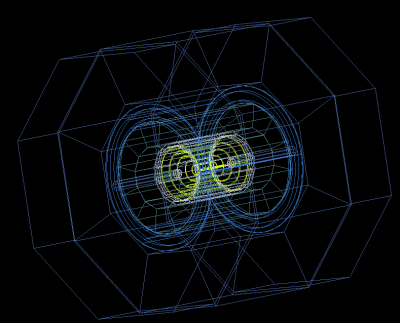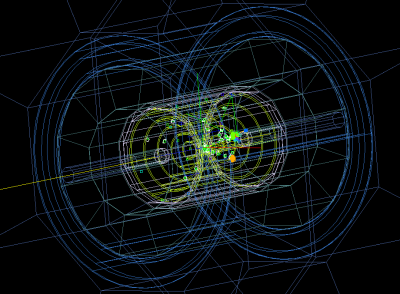User Tools
Sidebar
This is an old revision of the document!
Table of Contents
FCC-hh detector studies
This pages describes physics studies for a FCC-hh detector. You can find Monte Carlo samples in the LCIO format using the rfull005 search link. This link prints all event samples after full detector simulations (“tag rfull005”). Select “info” and then find the tag “rfull001” which prints LCIO files for a given MC sample. You can download such samples as discussed in HepSim manual.
The results shown on this page have been updated using Jas4pp data-analysis package. The installation does not have external dependencies besides Java. Make sure Java7 and above is installed. Then run these commands to install the package using Linux/Mac with the “bash” shell:
wget http://atlaswww.hep.anl.gov/asc/jas4pp/download/current.php -O jas4pp.tgz tar -zvxf jas4pp.tgz cd jas4pp source ./setup.sh # takes 5 sec for first-time optimization
The last command optimizes Java packages for the Python language. Now you are ready to run over any file with truth-level and datector-simulation files, such as LCIO and ProMC. This program allows you:
- Downloading and searching HepSim data
- Processing ProMC files from HepSim
- Running over SLCIO files with Geant4 simulated / reconstructed events.
- Data analysis (jets, physics vectors, histogram packages)
- Visualisation of reconstructed events using Wired4 display
You can find more details in HepSim manual. All examples for this page are located in the “examples/slic/” directory.
LCIO event structure
The standard set of containers is available from the LCIO files posted on HepSim. Read Manual. The API is described in LCIO Java API description.
Look the Java API definition of the needed objects in org.lcsim.lcio
BeamCalHits CalorimeterHitRelations EM_BARREL EM_ENDCAP EcalBarrelHits EcalEndcapHits HAD_BARREL HAD_ENDCAP HcalBarrelHits HcalEndcapHits HelicalTrackHitRelations HelicalTrackHits HelicalTrackMCRelations LumiCalHits MCParticle MUON_BARREL MUON_ENDCAP MuonBarrelHits MuonEndcapHits PandoraPFOCollection ReconClusters SiTrackerBarrelHits SiTrackerEndcapHits SiTrackerForwardHits SiVertexBarrelHits SiVertexEndcapHits StateAtECal StateAtEnd StateAtStart TKR_RawTrackerHits TKR_TrackerHits Tracks VXD_RawTrackerHits VXD_TrackerHits
Detector geometry
The Monte Carlo files located in rfull001 link are done using the sidloi3 detector: http://lcsim.org/detectors/sidloi3.html. The XML geometry is given in http://lcsim.org/detectors/sidloi3.zip.
The SiD detector is shown here 
You can view detector geometries posted in http://lcsim.org/detectors/ as this. Download zip file and extract it. Find file “compact.xml”, and then run geometry converter as:
gconverter -o heprep compact.xml sidloi3.heprep
Now you can open this file in the Jas and view it. Look at other options by running “./gconverter_gui”.
Here are a few links to the description of this detector.
SiD detector description and SiD detector description (older version)
Using C++/ROOT with LCIO
If you need to read LCIO files in C++ code with ROOT/FastJet, use this example package:
wget http://atlaswww.hep.anl.gov/hepsim/soft/lcio-cpp.tgz -O - | tar -xz; cd lcio-cpp; make
It will compile “example.cpp” file linking FastJet package. Look at README file to see how to install the “LCIO” package required by this example. Your LCIO“ files from HepSim should be in the directory “data”.
Analysing truth-level files
You can run over the original truth-level files from HepSim:
wget http://mc.hep.anl.gov/asc/hepsim/events/ee/250gev/pythia6_zpole_tautau/macros/pythia6_zpole_tautau.py fpad pythia6_zpole_tautau.py
This example prints the pT distribution of e, mu, taus. Typically, HepSim contains validation files with the extension py that can check the validity of truth-level samples. See the description in HepSim documentation and HepSim API
Visualizing events with Jas+Wired
You can run Jas+Wired to visualize the simulated events. The Wired program is included in the Jas4pp program, so you simply run it as:
jaspp
This will start Jas3 with all needed plugins. Then copy the detector geometry file to the local directory where the file “jas” is:
wget http://atlaswww.hep.anl.gov/hepsim/soft/detectors/sidloi3.tgz -O - | tar -xz;
This will create a directory “sidloi3”. This detector corresponds to “rfull001” tag used for the reconstruction of pythia6_zpole_ee (Z→e+e-).
Now we can visualize the detector as [File]-[Open data source]-[HepRep] XML and select the file “sidloi3/sidloi3.heprep”. This is how to do this using the command line:
jaspp sidloi3/sidloi3.heprep
You will see the detector layout:
Now, we will read the event: Open any *.slcio file you copied from HepSim as [File]-[Open data source]-[LCIO] file. Then click a small button [Go] (top menu bar). It will process events. Then select again [File]-[New]-[Wired 4 view]. You will get an image in the Wired4 display as this:
Now press [Go] again to look at next event.
If you want to see how data records are organized inside the slcio file, do this [File]-[New]-[LCSim Event browser]
People
This collection of tools for future collider studies was developed at ANL (S.Chekanov, [email protected]) in collaboration with Jan Strube (PNNL) ([email protected]) and Ashutosh Kotwal (Duke U) [email protected]. The Java part of the simulator for the linear collider was designed N. Graf, J. McCormick, T.Jonson
FAQ
For some help with SLIC, read:
https://confluence.slac.stanford.edu/display/ilc/ILC+Detector+Simulation+FAQ
https://confluence.slac.stanford.edu/display/ilc/LCSim+Tutorials
~~REFNOTES~~
— Sergei Chekanov 2015/10/08 09:31



